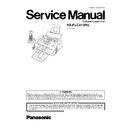Panasonic KX-FLC413RU Service Manual ▷ View online
49
KX-FLC413RU
7.12.10.1. Toner Detection Flow
CAUTION:
1. Toner low can be judged by continuous 5-times TONER LOW signal at only printing.
(It is not executed at.)
2. Toner full can be judged by continuous 3-times TONER FULL signal at initialization.
(It is not executed at printing.)
3. In the ordinal operation, “CHECK DRUM” is displayed when TONER EMPTY sensor does not generate a signal for 3.1 sec-
onds.
50
KX-FLC413RU
7.13. Operation Board Section
The unit consists of a LCD (Liquid crystal display), KEYs and LEDs (light-emitting diodes). They are controlled by the Gate Array
(IC101) and ASIC (IC107: on the DIGITAL BOARD).
The key matrix table is shown below.
(IC101) and ASIC (IC107: on the DIGITAL BOARD).
The key matrix table is shown below.
1. Key Matrix
a. Hard Scan
*LED7 should be set to KSL4. "8 x 5" key matrix is executed by hardware scanning.
2. LED
• AUTO ANSWER LED ON/OFF port---LED2
• NEW MESSAGES LED ON/OFF port---LED3
• NEW MESSAGES LED ON/OFF port---LED3
KIN0
KIN1
KIN2
KIN3
KIN4
KIN5
KIN6
KIN7
KSL0 S1
S2
S3
S4
MONITOR
FAX START
S5
LOWER
KSL1 PLAYBACK
4
5
6
FLASH
MENU
PREV
HELP
KSL2 LOCATOR/INTERCOM
*
0
#
MUTE
STOP
VOL-
COPY
KSL3 ERASE
7
8
9
REDIAL/PAUSE QUICK SCAN
SET
AUTO ANSWER
KSL4 GREETING
1
2
3
CID SEARCH
NEXT
VOL+
AOH
CN102
CN110
IC107
G/A
LCD MODULE
CN101
8x5
KEYS
MATRIX
(Hard)
KEYS
MATRIX
(Hard)
LED
DIGITAL BOARD
OPERATION BOARD
GATE ARRAY IC
IC101
51
KX-FLC413RU
7.14. LCD Section
The Gate Array (IC101) works only for writing the ASCII code from the data bus (D4~D7). V0 is supplied for the crystal drive.
R123 and R124 are density control resistors.
Consequently, in this unit, the timing (positive clock) is generated by the LCD interface circuitry in the gate array (IC101).
R123 and R124 are density control resistors.
Consequently, in this unit, the timing (positive clock) is generated by the LCD interface circuitry in the gate array (IC101).
52
KX-FLC413RU
7.15. Transmitter / Receiver (Cordless)
Base Unit and Cordless Handset mainly consist of RF Module and DECT BBIC.
Base Unit and Cordless Handset transmit/receive voice signal and data signal through the antenna on carrier frequency.
Base Unit and Cordless Handset transmit/receive voice signal and data signal through the antenna on carrier frequency.
7.15.1. Transmitter Block
The voice signal input from the TEL LINE interface goes to RF Module (IC2) through DECT BBIC (IC4).
The voice signal passes through the analog part of IC4 where it is amplified and converted to a digital audio stream signal. The
burst switch controller processes this stream performing encryption and scrambling, adding the various other fields to produce
the GAP (Generic Access Profile) standard DECT frame, assigning to a time slot and channel etc.
In IC2, the carrier frequency is changing, and frequency modulated RF signal is generated and amplified, and radiated from
antenna. Cordless Handset detects the voice signal or data signal in the circuit same as the following explanation of Receiver
Block.
The voice signal passes through the analog part of IC4 where it is amplified and converted to a digital audio stream signal. The
burst switch controller processes this stream performing encryption and scrambling, adding the various other fields to produce
the GAP (Generic Access Profile) standard DECT frame, assigning to a time slot and channel etc.
In IC2, the carrier frequency is changing, and frequency modulated RF signal is generated and amplified, and radiated from
antenna. Cordless Handset detects the voice signal or data signal in the circuit same as the following explanation of Receiver
Block.
7.15.2. Receiver Block
The signal of 1900 MHz band (1881.792 MHz ~ 1897.344 MHz) which is input from antenna is input to IC2.
In IC2, the signal of 1900 MHz band is down converted to 864 kHz signal and demodulated, and goes to IC4 as GAP (Generic
Access Profile) standard DECT frames. It passes through the decoding section burst switch controller where it separates out the
frame information and performs de-encryption and de-scrambling as required. It then goes to the DSP section where it is turned
back into analog audio. This is amplified by the analog front end, and goes to the TEL LINE Interface.
In IC2, the signal of 1900 MHz band is down converted to 864 kHz signal and demodulated, and goes to IC4 as GAP (Generic
Access Profile) standard DECT frames. It passes through the decoding section burst switch controller where it separates out the
frame information and performs de-encryption and de-scrambling as required. It then goes to the DSP section where it is turned
back into analog audio. This is amplified by the analog front end, and goes to the TEL LINE Interface.
7.15.3. Power Supply Circuit (Cordless Base Unit)
The power is supplied to the DECT BBIC, RF Module, EEPROM and FLASH MEMORY as shown below figure.
The power supply is as follows;
The power supply is as follows;
• DECT BBIC (IC4):
CN921 8, 9 pin (+4V)
→ Q8 → IC4
CN921 8, 9 pin (+4V)
→ Q6 → IC4
• RF Module (IC2):
CN921 8, 9 pin (+4V)
→ IC28 → IC2 (PLL)
CN921 8, 9 pin (+4V)
→ IC28 → R411, R412 → IC2 (Power AMP)
• EEPROM (IC22):
CN921 8, 9 pin (+4V)
→ Q8 → IC22
• FLASH MEMORY (IC23):
CN921 8, 9 pin (+4V)
→ Q8 → IC23
Click on the first or last page to see other KX-FLC413RU service manuals if exist.

